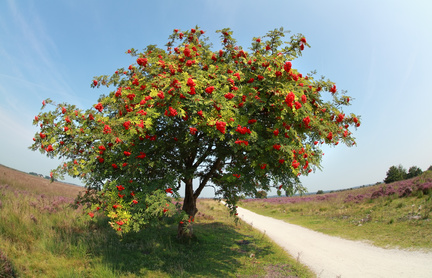Rowan Tree

All you need to know about the rowan tree, from tips on how to identify it, to typical characteristics; how to spot common diseases and pests and the best way to maintain a rowan tree.
The rowan tree is a UK native species. Also known as the mountain ash because it is able to survive high altitudes, and also because its pinnate leaves are very similar to those of the common ash, this tree is well known for its stunning white spring flowers followed by striking bursts of bright red berries in late summer to early autumn. It’s a deciduous tree known to grow up to 15 metres in height and to live up to 200 years.
The rowan tree has a few other alternative names including witch wiggin, keirn and cuirn.
Witch wiggin as a name derives from the fact the rowan tree used to be planted by homeowners to protect against witches. In Ireland it was grown specifically to ward off evil spirits, and in Wales the rowan tree would regularly be seen in churchyards. In Scotland, it was forbidden to fell a rowan tree.
General Facts
| Known as | Rowan |
| Latin name | Sorbus aucuparia |
| Location | UK native, Europe; Asia |
| Foliage | Deciduous |
| Lifespan | Up to 200 years |
Characteristics
| Height | Up to 15 metres |
| Spread | 4-8 metres |
| Appearance | An upright deciduous tree with silvery-grey, smooth bark and purple, hairy leaf buds. |
| Leaves | Leaves are pinnate and turn from green to yellow in autumn. There are 5-8 pairs of long, oval serrated leaflets together with one terminal leaflet at the end. |
| Flowers | Rowan flowers appear in dense clusters with each presenting five creamy white petals. |
| Fruit | Rowan fruits are prominent, scarlet berries that appear in late summer to early autumn. |
| Found in | Streets and gardens |
Conditions
| Ideal soil | Well drained loam or sand |
| Soil pH | Neutral, acid |
| Aspect | North, south, east or west facing |
| Exposure | Full sun to partial shade; Sheltered or exposed |
Threats
| Pests | Aphids, blister mites, sawflies |
| Diseases | Fireblight, silver leaf disease |
Rowan Trees and Wildlife
Moth caterpillars are particularly partial to rowan leaves, especially the autumn green carpet moth and the Welsh wave moth. Apple fruit moth caterpillars enjoy rowan berries, as do numerous birds including the blackbird, the mistle and song thrush, the redstart, redwing, waxwing and fieldfare. The flowers of the tree are rich in pollen and nectar, so attractive to bees and other pollinating insects.
Rowan Tree Symbolism and History
Years ago, rowan trees were often planted by householders to protect against witches. The bright scarlet red berries were considered effective in fighting evil, which is why this tree has long been associated with witches and magic. The Celtic name for the rowan tree is ‘fid na ndruad’, meaning ‘wizards’ tree’. People would often use rowan wood to stir milk to prevent it curdling, and it was also used to make divining rods.
The Importance of Rowan Trees
The pale, yellowy-brown wood of the rowan tree with its distinctive deep-brown heartwood is sometimes used in furniture making, wood-crafting and engraving. The rowan tree is a popular street tree, and its berries are edible and rich in vitamin C, sometimes used to make savoury jellies as meat accompaniments.
Caring for a Rowan Tree
Because the fruit of the rowan tree grows in abundance, it will often weigh heavy on the branches. This makes it essential to carry out regular rowan tree pruning so that there is a robust framework to support the fruit. Otherwise branches are likely to break off, presenting hazards and posing a risk to the health of the tree.
Regular pruning will promote good health by allowing air and sunlight to penetrate as well as letting wind to pass through without barriers, so preventing storm damage. It’s also good to remove crossing or damaged branches so that a clear trunk is left.
Never prune a rowan tree during the growing season because the sap will attract bugs and diseases. Autumn to early winter is considered the most appropriate time for rowan tree pruning, although any time of year is acceptable for dead wood removal.
For more about Rowan tree pruning, follow this link.
If you have a rowan tree that would benefit from expert care and attention, why not get in touch with Tree Works? As fully qualified and highly experienced tree surgeons, we can offer detailed skill and knowledge across all areas of rowan tree care. For a free, no-obligation quotation, call us on 07781 416 354 or get in touch here.

